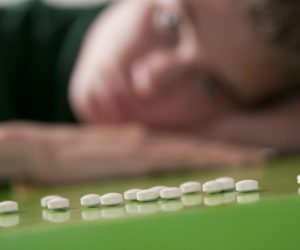Dangers of Prescription Drugs Among Teens

The dangers of prescription drugs when they’re not taken as directed include legal, health, and relationship problems as well as addiction and dependence.
New teenage prescription drug abuse statistics by the National Center for Health Statistics shows that drug overdose deaths among teens between the ages of 15 and 19 increased by 19 percent between 2014 and 2015. Largely driven by the opioid epidemic, the growing teen overdose problem commonly involves prescription painkillers like OxyContin and illustrates the dangers of prescription drugs. Despite these alarming statistics, drug overdose deaths are still very low among teenagers, who represented just 1.4 percent of the 52,404 drug overdose deaths that occurred in 2015.
But drug overdose is just one of the many dangers of prescription drugs. Prescription drug abuse among teens leads to serious problems at school and home as well as relationship, health, and even legal problems.
Most Commonly Abused Prescription Drugs
Research shows that a large percentage of teens and their parents believe that prescription drug abuse is safer than illegal drug abuse, because prescription drugs are prescribed by a doctor. But in prescribing drugs, physicians take into account a number of factors, including the patient’s weight, age, other medications they take, and how long it takes for a particular pill or capsule to dissolve and release the medication. Taking someone else’s prescription can lead to serious drug interactions, overdosing and dangerous side effects.
The most commonly abused prescriptions among teenagers are opioid painkillers, central nervous system sedatives like the benzodiazepines Xanax and Klonopin, and central nervous system stimulants like Adderall and Ritalin.
The dangers of prescription drugs in the opioid class include reduced respiratory and heart rate. Some opioid medications, such as fentanyl, are many times more powerful than others, and teens who don’t know what they’re taking or what a pill’s dosage is are at a high risk of overdosing.
The dangers of prescription drugs like Adderall and Ritalin can lead to dangerously high body temperature, irregular heartbeat, and paranoia. Abusing sedatives can cause dangerous effects like shallow breathing, disorientation, and long-lasting learning problems.
Because teenagers’ brains and bodies are still developing, they’re more susceptible to long-term problems stemming from prescription drug abuse, which may include problems with judgment and inhibition. These, in turn, may lead to an increased risk of HIV and other sexually transmitted diseases as well as problems related to engaging in other high-risk behaviors.
One of the biggest dangers of prescription drugs being misused by teenagers is the risk of developing an addiction or dependence on them.
Addiction and Dependence
Heavy drug abuse causes changes in the brain’s physical structures and chemical functions. These changes can lead to addiction and dependence.
Addiction is characterized by compulsive drug use even though the drugs are causing problems in your life, such as relationship, financial, legal, or health problems. Once an addiction develops, professional help is almost always needed to end it for the long-term.
Dependence is a physical reliance on drugs. As the brain changes the way it functions in order to compensate for the presence of the drugs, increasingly larger doses are needed to get the desired effects. At some point, brain function may shift so that the brain now operates more comfortably when drugs are present than when they’re not. When drugs are withheld, normal brain function rebounds, and this causes withdrawal symptoms. Withdrawal symptoms are an indication that a dependence has been developed. Medical detox is essential for safe withdrawal from prescription drugs.
Causes of Prescription Drug Abuse
Drug abuse almost always has underlying causes. Teenage prescription drug abuse statistics show that teens report abusing prescription drugs for a variety of reasons:
- To fit in.
- To cope with stress.
- To get high.
- To lose weight.
- To improve academic or athletic performance.
These aren’t the only causes of prescription drug abuse. According to the National Institute on Drug Abuse, recent research has raised concerns that the legitimate prescribing of opioid painkillers to teens can lead to opioid misuse and addiction later on. According to the study, teens who were prescribed opioid pain medication were at a 33 percent increased risk for misusing opioids between the ages of 19 and 25, even among the lowest-risk groups. Researchers suggest that the pleasurable effects of opioids, along with the perception that they’re safe, may account for misuse later on.
Preventing Teenage Drug Abuse
Preventing teenage drug abuse is a major priority in the U.S. and requires a three-pronged approach:
- Education. Educating teens, parents, and prescribers about prescription drug abuse is the focus of numerous government, medical, and community organizations.
- Safe medication storage and disposal. Two-thirds of teens who abuse prescription drugs get them from family and friends, often straight from the medicine cabinet. Storing prescriptions under lock and key or other safeguards reduces access.
- Prescription drug monitoring. Prescription medications are prescribed far more often than they were just ten years ago, and pharmacists aren’t required to check registries that can identify over-prescribing and misuse. A number of government and community organizations are working to improve prescription drug monitoring in the U.S.
If you or a teenager you love is abusing, addicted to, or dependent on prescription drugs, WhiteSands Treatment can help through a high-quality, holistic, and age-appropriate treatment program.
If you or a loved one needs help with abuse and/or treatment, please call the WhiteSands Treatment at (877) 855-3470. Our addiction specialists can assess your recovery needs and help you get the addiction treatment that provides the best chance for your long-term recovery.
